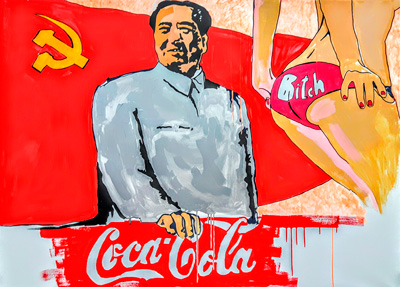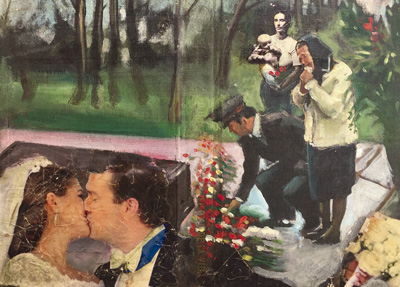Memories of an Imagined Identity
By Isdanny Morales
The Sergio of Memorias del Desarrollo, like the Sergio in Alea’s film, wanders as an autistic in the city. He watches, touches and analyzes everything; however, beyond himself everything appears as an island and all bridges have been broken. Garcet is a castaway in the center of New York, an immigrant whose immediate relation with “reality” is intervened by the distancing, the negation and apathy. His present is based on memories recreated from the juxtaposition of squizoid images from photographic archives, press releases or letters, recordings or music themes that create a sort of psychic palimpsest.
The trace of a fragmented memory is also registered in the work of the young Cuban artist Reynier Llanes (Pinar del Río, 1985) established in the United States. Imaginary scenes and passages from two different geographies mix randomly in it. His characters are the prototypes: mercenaries, dandies, gangsters or golf players. He retakes some guess work on popular religiosity, eroticism and the temperature of a dreamt island or industrialization and consumption. In his work the playful element challenges the spectacular side of daily life, the loneliness, the hyper-rationalization and vice versa. Pieces such as Where did you grow up? (2017) or Chant in Midnight Hill (2017) give testimony of it.
Llanes has a precise technical mastery of the painting resources, an exquisite ability to manipulate color, bring out lights and mold figures by slightly blurring their outlines. His work at some point most surely appeals to masters of North American realistic painting. Many of his pieces are delectable to the eye; such is the case of Enigma (2017). However, in my opinion, the most daring are the ones in which the technical craftsmanship mixes with the symbolic invention, when he distances himself from the typical character and the customs realism that tends to represent characters, objects and nature in general with conventional details and the meaning is created by appealing to the expressive possibilities of rhetoric and painting resources in general. It is then that the metaphor becomes more enigmatic and the reception turns ambiguous, unleashing multiple reading possibilities. Such is the case of Resurrection (2017) and Mapping Destination (2016).
In the first of these works a scene is presented where three figures dialog about nuclear weapons. In cinematographic style he builds a setting as if seen from a lower level. The masculine bodies are fragmented in ellipsis, the missile is hyperbolized. When we stand in front of Resurrection the frame from below puts us stealthily inside a box, a tunnel or a hiding place. The slightest movement may betray us as intruders. In any case, none of us are invited to this meeting. Reynier reminds us that the decisions on the fate of the world are ultimately taken by a few that exert power. We must remain on the sly. Using a trap of perception, this piece becomes one of his most challenging compositions.
In Mapping Destination, a man wearing a suit is inside a car in movement. More than human, he resembles a cyborg. His hard features, cold color and distinctive red flash in his glance betray him. The skin and clothes must cover the iron structures. The organic nature mixes with the technological devices. A prodigy of cybernetics. His name is probably T-800 or RR-37. Although not explicitly shown in the work, we can guess each of the attributes that make up our image of the mutant by some minimal signs of meaning left by the artist on the canvas. With this piece we dare to penetrate symbolically the hiding places of post-human identity, a theme that appears repeatedly in the philosophical debate of the 21st century.
I could speculate that the artist is interested in several themes derived from his experiences in the island: conversations, headlines, aesthetic and ideological theses of films and TV series, forms of life in general… He chooses from the memory and recombines in visual images. The theme of memory in his work also becomes a squizoid or alienated experience, but unlike Sergio Garcet, in Llanes’s work we witness the self-acceptance of a multiple, fragmented and multicultural ego. The traces of his journey and eventually of exile create an identity in his works that is mostly imagined. Reynier builds bridges; he does not destroy them…



